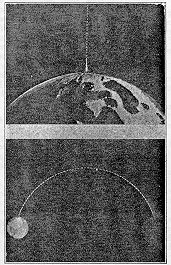
AN EASY EINSTEIN PROBLEM
(Edwin E. Slosson gives the following interesting account of a problem in relativity.)
The idea recently introduced by Albert Einstein that all things are relative, that measurements of time and space depend on the position of the observer, is commonly regarded as new and incredible. Yet some illustrations of the general idea are easy enough to understand and not at all novel. In a motion picture film made under the supervision of Einstein and shown in this country, the case of a cannon ball is depicted.
Suppose a cannon is set up perpendicularly at the North Pole (where there is no motion of the earth spinning on it axis) and fired straight up into the air. A man standing on the earth near by and watching the projectile would see it—if it were not too swift—go up and down in a straight line. If we assume that the gun is aimed straight upright and the projectile is well balanced and there is no wind or anything else to divert it from its course, then the projectile would fall back into the barrel, say, a minute later.
But the earth in that minute has moved forward in a curved orbit a distance of 1,110 miles. An observer stationed somewhere off in space on the sunward side, or on the sun, if he had a good enough telescope, would see the course of the cannon ball —not as a straight up-and-down line— but as a long curve and he might marvel at the skill of the gunner who could hit a moving target more than a thousand miles away.
Now which is right, the man on the earth who sees the course of the ball as a straight line or the man on the sun who sees it as a curve?
Obviously both are right, since they are looking at the same thing. It all depends on the point of view. Motion is a matter of relativity.